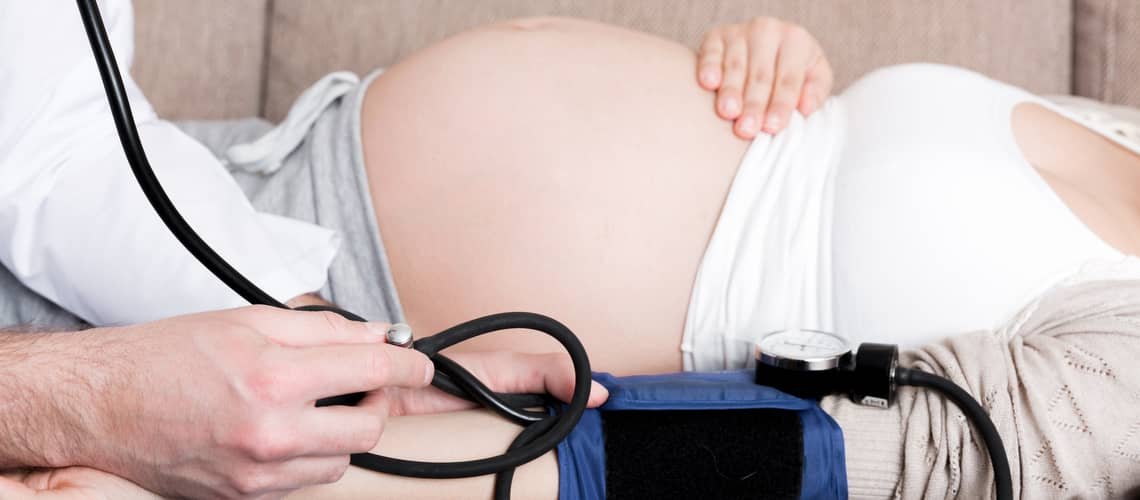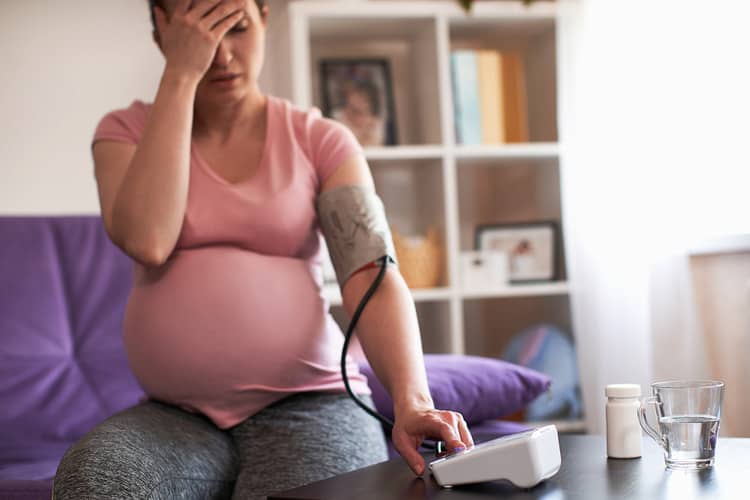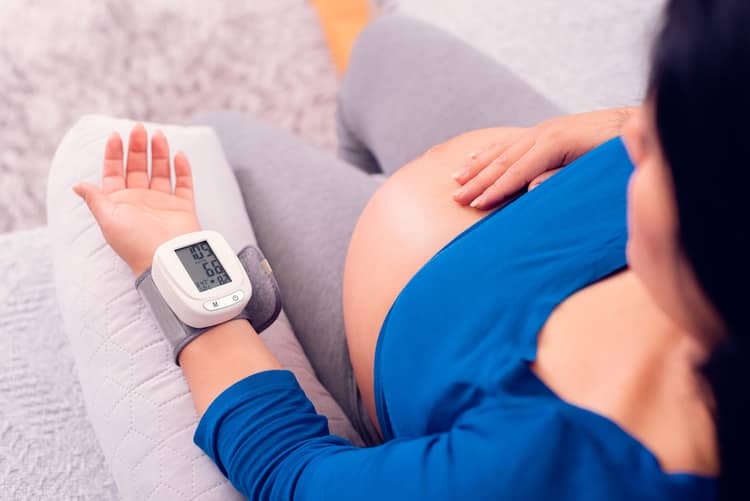
High blood pressure in pregnancy. Symptoms and treatment, how to reduce pressure
Not too tall, not too short. We are talking about blood pressure in pregnancy. High blood pressure, hypertension, in pregnancy, like low blood pressure, hypotension, is never very good news for a pregnant woman. At the same time, pressure changes in the body during pregnancy are completely normal. Pressure during pregnancy, primarily during the first and second trimester, fluctuates significantly, which can cause it to increase or decrease. Lightheadedness, dizziness, swollen legs, blurred vision or fainting? The symptoms of high blood pressure can be different during pregnancy, but the basis is its regular monitoring. Correct blood pressure is very important for the functioning of our entire organism, but it is also affected by a number of factors, from stress to drinking regime to psychological state. What does high bottom pressure mean? How to reduce high blood pressure during pregnancy?
- Blood pressure - characteristics
- Systolic vs diastolic pressure
- Optimal and high blood pressure
- Regular control of blood pressure during pregnancy
- High blood pressure in pregnancy - symptoms
- The danger of high blood pressure
- Preeclampsia and eclampsia in pregnancy
- High blood pressure in pregnancy - treatment and recommendations
- Low blood pressure in pregnancy is a problem
- High blood pressure in pregnancy - experience
- The most frequent questions - FAQ
- Comments
High blood pressure in pregnancy can be a temporary condition, but it can also be a diagnosis that requires regular monitoring. Hypertension can complicate many things during pregnancy, and especially for the woman herself, it is a phenomenon that can make pregnancy really unpleasant. At the same time, it represents a risk for the fetus itself. Although blood pressure is talked about quite often and concepts like high and low pressure are often known and popularized, few people can explain what blood pressure is and what role it actually plays in the body. In our article, you will read what blood pressure is, why it is divided into systolic and diastolic, and we will also advise you on how to reduce high blood pressure during pregnancy. You will also learn the difference between high and low blood pressure.
Blood pressure - characteristics
The definition of blood pressure could be expertly broken down into a multi-page study. However, it is important to understand what blood pressure is and what role it plays in our organism. Blood pressure can be characterized as the force - energy of the blood, which under a certain pressure acts on the vessel walls. This force is necessary for the blood in our body to flow in the vessels and to distribute the blood cells throughout the body. Blood pressure varies according to the vessels in which the blood flows - aorta, arteries, veins, capillaries.
All of them are important, but in connection with blood pressure, the arteries that distribute oxygenated blood away from the heart (note the exception is the pulmonary artery - pulmonary artery, which brings deoxygenated blood from the right ventricle to the lungs) towards the tissues play an important role. They have very elastic and strong walls. It is in the arteries that sufficient force is needed for the blood to flow. Veins take deoxygenated blood from the tissues to the heart. Capillaries are fine and thin blood vessels that connect arteries and veins. To give you an idea of blood pressure, the veins have thinner walls and therefore it is not necessary to have such a strong blood pressure in order for the blood to flow in them. This is also why when their wall is damaged, blood does not spray, but flows out. On the contrary, the blood pressure in the arteries is higher and blood can splash when larger arteries are injured. Blood pressure measured with a sphygmomanometer is thus measured in the arteries that carry blood away from the heart.

Systolic vs diastolic pressure
In a simplified way, we further divide blood pressure into systolic (upper) and diastolic (lower). The whole process consists of two phases of the heart, which pumps blood into the body. When the heart contracts, the systolic pressure (phase of systole) ensures that oxygenated blood is ejected under sufficient pressure into the aorta (the largest artery of the human body) and the entire bloodstream. In the next step, the diastolic pressure (phase of diastole) ensures that the heart in the relaxation phase (in a relaxed state) is again filled with deoxygenated blood. When measuring with a sphygmomanometer, the first number (larger) is the systolic pressure and the second number (lower) indicates the diastolic pressure. In these two phases, the heart pumps oxygenated blood into the circulation and at the same time supplies itself with deoxygenated blood.
Optimal and high blood pressure
The ideal blood pressure in all circumstances, even in the case of a pregnant woman, is considered to be 120/80 mmHg/torr. The mmHg data was created as a designation of a millimeter of mercury column (mercury – Hg). In the case of blood pressure, this value is also called torr. A value above 90 is considered an elevated diastolic pressure (lower) and a value above 140 is considered an elevated systolic pressure (upper). If the measured blood pressure is 140/90 mmHg/torr, it is a mild degree of hypertension. A moderately severe degree of hypertension is from a value of 150/100 mmHg, severe hypertension is diagnosed with a repeated measurement of a value of 160/110 mmHg. An absolutely serious state of hypertension means a value of 170/110 mmHg or more.
Regular control of blood pressure during pregnancy
In pregnancy, it is crucial that the attending physician monitors the blood pressure of the pregnant woman throughout the pregnancy. This is one of the strictly monitored parameters. Above all, pressure fluctuations occur in the first and second trimesters. This phenomenon is considered normal because the body copes with many hormonal, physiological and psychological changes. The vessels expand, the volume of blood increases, and not only the organism of the pregnant woman is supplied, but also the fetus through the placenta.
Few people realize it, but blood pressure is not only affected by physical activity and the classic scene when you walk up the stairs to the waiting room and immediately have your blood pressure taken. Blood pressure values are also influenced by the level of stress, drinking habits, sleep, eating habits or the woman's psyche. Gynecologists agree that it is necessary to regularly monitor blood pressure during pregnancy and find out the specific cause of increased pressure.

High blood pressure in pregnancy - symptoms
A regularly and independently measured value above 140/90 mmHg (at least two measurements) is considered high blood pressure. White coat syndrome is ruled out by repeated measurement. High blood pressure occurs in 2-8% of pregnancies. Usually, symptoms related to high blood pressure - hypertension begin to appear after the 20th week of pregnancy. It is about the so-called gestational high blood pressure, which arises as a result of the body's reaction to the burden of pregnancy. A common problem with high blood pressure in pregnancy is that a woman attributes its symptoms to typical pregnancy symptoms. How can hypertension - high blood pressure - manifest itself in a pregnant woman?
- Dizziness to fainting - feeling like passing out,
- frequent or intense headaches – often in waves,
- blurred vision, fogging in front of the eyes - especially after physical exertion or faster movement,
- faster fatigue and increased shortness of breath,
- swelling of the limbs in the lower part of the body,
- less frequent urination or other urine color (turbidity),
- faster weight gain (preeclampsia).
One of the often occurring cases is that the woman had problems with high blood pressure already before pregnancy or the pressure increased significantly during the 1st trimester. It is about the so-called chronic increased pressure (pre-existing hypertension), which can manifest itself in the first weeks of pregnancy, and such a pregnant woman needs to be monitored very carefully and monitor the levels of systolic and diastolic pressure. It happens that until about the 20th week of pregnancy, the blood pressure stabilizes and fluctuates only occasionally (mainly in the 1st trimester), but in the second half of the pregnancy, the blood pressure rises significantly and can cause serious problems.
The danger of high blood pressure
There are many potential risks associated with high blood pressure in pregnancy. Hypertension is a condition that is a risk for both mother and child. The degree of risk depends on the stage of hypertension and the body's response to treatment. The greatest risk for a woman is the development of preeclampsia, eclampsia or an increased risk of premature birth. In general, with high blood pressure, important organs are not optimally supplied with blood. There is also a risk of damage to blood vessels and organs, such as kidneys, heart, liver, lungs or uterus. Especially when preeclampsia develops.
High blood pressure is dangerous for the child mainly because of its development. A common consequence of hypertension is slowed growth of the child in the womb, low birth weight, impaired adaptation of the child after birth or increased risk of miscarriage. The reason is that high blood pressure can cause the blood flow from the placenta through the umbilical cord to be slowed down and the necessary amount of nutrients not reaching the fetus.
The reasons for high blood pressure are not precisely identified. Most likely, in the case of gestational high blood pressure, the reason is insufficient blood supply to the placenta (preeclampsia), due to which the fetus does not receive the optimal amount of nutrients. Risk factors for the development of high blood pressure in pregnancy are considered to be – pregnancy after 30, smoking during or before pregnancy, diagnosed diabetes (diabetes), obesity, multiple pregnancy or high blood pressure (chronic hypertension) diagnosed before pregnancy.

Preeclampsia and eclampsia in pregnancy
Preeclampsia is considered the most serious complication related to high blood pressure during pregnancy. Its development occurs without warning and why exactly it arises is not completely clear even to doctors and scientists. It usually starts after the 20th week of pregnancy and is dangerous for both mother and child. It occurs more often in women with the risk factors mentioned in the paragraph above (age over 30 years, obesity, diabetes...), but also in women who have had preeclampsia in a previous pregnancy or in a family history. Preeclampsia occurs in 6 to 8% of pregnancies.
The latest research shows that although the disease develops primarily in the second half of pregnancy, pressure fluctuations can already be a symptom in the first weeks. Its occurrence before the 34th week of pregnancy may also be related to a placental defect, due to which the fetus in the womb is nourished less efficiently. Attention, increased blood pressure in a pregnant woman does not automatically mean that it is preeclampsia. This is just one of its potential symptoms. Normally, preeclampsia is also manifested by swelling of the limbs or face, loss of protein during urination, rapid heartbeat, less often blurred vision, shortness of breath, sometimes fever and also a high content of uric acid in the blood. Failure to treat preeclampsia can have fatal consequences for mother and child.
The state of preeclampsia can cause inflammatory processes in the body and damage internal organs - kidneys, lungs, liver, heart muscle or brain. The most serious condition of preeclampsia is its development up to eclampsia. It can develop during pregnancy, during childbirth or during the six-month period. This is extremely high blood pressure (eg 210/130 mmHg). Eclampsia is accompanied by strong convulsive seizures, loss of consciousness, fainting and even amnesia. Sometimes the symptoms resemble epileptic seizures. Acute blood pressure reduction (combination of sedatives and magnesium) is necessary during treatment. If it develops before birth, it is recommended to terminate the pregnancy as soon as possible by vaginal delivery or cesarean section. Eclampsia is associated with increased maternal and newborn mortality.
The exact cause of preeclampsia (hypertensive disease) in pregnant women is not medically clear. Most often, doctors agree, as some researches and studies show, that the reason for the development of this disease is the immune reaction of the mother's body to the man's sperm, the placenta or the fetus itself. It also turns out that pregnancy is often a hereditary condition. If preeclampsia appeared during your mother's pregnancy, it is highly likely that you will also be diagnosed.

High blood pressure in pregnancy - treatment and recommendations
Hypertension can have genetic causes, but it can also develop suddenly or as part of another disease. Treatment of high blood pressure is relatively non-invasive. Typically, high blood pressure is controlled with effective medications. However, drugs of this type are in most cases unsuitable for pregnant women. Therefore, pharmacological treatment is approached only very exceptionally and depends on the stage of hypertension and the state of health of both mother and child. Most often, the doctor prescribes magnesium in the form of capsules. In case of a serious condition, the doctor may recommend hospitalization and strict monitoring in order to stabilize the condition.
The most effective treatment is a rest regime, sufficient fluid intake and, at the same time, adequate physical activity (walking, swimming, yoga, stretching). No heavy physical exertion is recommended. Avoid stress. It is recommended to limit salting and also to be careful about the intake of liquids in the form of mineral waters with a higher sodium content. A healthy, balanced diet and weight control are important. Beware of excessive intake of carbohydrates, it is also necessary to avoid too fatty and fatty foods. It is absolutely necessary to avoid alcohol and smoking. To monitor the progress of the disease, it is suitable to measure blood pressure even at home.
Low blood pressure in pregnancy is a problem
In general, high blood pressure rather than low blood pressure is considered a risk factor in pregnancy. The so-called hypotension in pregnancy does not have such precisely defined symptoms or characteristics as the aforementioned hypertension. However, pressure fluctuations are natural in pregnancy, and low blood pressure can also be a complication. A value lower than 100/60 mmHg is considered low blood pressure. If the pressure is repeatedly low, it does not automatically mean hypotension. Many women did not experience any significant complications from low blood pressure even during pregnancy.
However, low blood pressure can have a negative effect on a woman's body, and the symptoms include fainting, dizziness, vertigo, nausea or sweating. Some studies attribute palpitations, anxiety, thirst, muscle weakness, drowsiness, or pale skin to symptoms of low blood pressure. Low blood pressure can also be a symptom of another disease. A drop in pressure can also be caused by certain medications, malnutrition, allergic reactions, anemia or cardiovascular diseases. It often happens that after standing up suddenly, the pressure in the brain is not balanced and dizziness can occur.
In connection with low blood pressure, doctors check blood sugar levels, hemoglobin content in the blood (deficiency indicates an anemic state) and may recommend an EKG (heart activity) examination. In the event of a drop in blood pressure, the drinking regime is important. It is ideal to drink mineral waters containing sodium, potassium, iron, vitamin D. Regular walks, plenty of rest and elimination of stress are recommended. Always consult your doctor about symptoms of low blood pressure and do not underestimate this condition either.

High blood pressure in pregnancy - experience
About 6 to 8% of pregnant women experience high blood pressure during pregnancy. In discussions and posts on forums, women most often discuss the optimal pressure at a particular stage of pregnancy. Several women recommend mothers to monitor their blood pressure at home and get a blood pressure monitor and keep a diary where they will write down the blood pressure value. It is important to measure it in peace. Some women state that in their case there was immediate hospitalization and daily monitoring. In some cases, women struggled with pressures of 170/115 torr or 165/125 torr and more, when hospitalization was the most appropriate solution. Several mothers also communicate that occasional pressure fluctuations and mild hypertension may not automatically be a problem of preeclampsia. Especially in the later phase of pregnancy, e.g. after the 37th week, when their high blood pressure was measured, the women reported that they were hospitalized, the pressure stabilized, and labor was induced. The most important thing is to always consult the attending physician about possible symptoms.
The most frequent questions - FAQ
Does or did high blood pressure during pregnancy also bother you? What is your experience with hypertension in pregnancy? How was the treatment for you? We will be happy if you share your experience with us in the discussion under the article. If you have any questions, write us a comment and we will try to answer you as quickly as possible. In the article, you will find important information about high blood pressure during pregnancy, as well as its symptoms and treatment. If you have an idea about what to add to the article, do not hesitate to write to us.
What is hypertension?
What is preeclampsia?
What does a high pulse in pregnancy mean?
Pridať komentár







